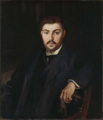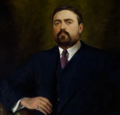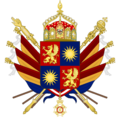Empire of Solraak
Empire of Solraak Solraak | |
|---|---|
| Motto: "Veritas Lux Mea" "The truth is my light" | |
| Anthem: | |
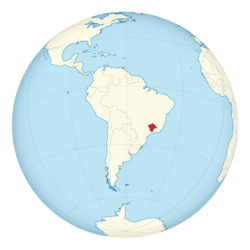 | |
| Status | Active |
| Capital and largest city | Lux Aurea |
| Official languages | Portuguese |
| Religion |
|
| Demonym(s) | Solraki or Solrakian |
| Government | Parliamentary constitutional monarchy |
• Emperor | Henrique I |
• Prime Minister | Anthony C. Müller |
| Legislature | Parliament |
| Independence from Brazil | |
• Independence | 18 March 2023 |
• Constitution ratified | 1st May 2023 |
| Population | |
• 2023 estimate | 15 |
• 2023 census | 15 |
| Membership | ▲ 18 |
| HDI (2023) | ▼ 0.802 very high |
| Currency | Solar |
| Time zone | UTC-3 (São Paulo, SP, Brazil) |
| Date format | dd-mm-yyyy |
| Driving side | right |
Government and Politics
Solraak is a parliamentary monarchy whose head of state is His Imperial Majesty Henrique I and the current head of government is the Prime Minister. Solraki politics is organized between four Branches or Powers: the Moderator, the Executive, the Legislative and the Judiciary.
Moderator Branch
The solraki monarch, currently Henrique I, is the head of State. Regarding him, the "Unwritten Constitution" of 2014 declares that the "person of the Emperor is inviolable and sacred; he is not subject to any responsibility". The powers that fall to the Crown are called "Royal Prerogative" and can be applied in the most diverse spheres of action: issuing of passports, dismissal of ministers, declarations of war, etc. The attributions reserved to the Moderating Power should be exercised only after the Council of State has been consulted.
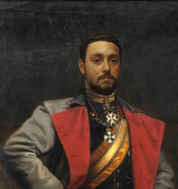
His Majesty's Duties:
- Appoint and dismiss the Prime Minister according to the popular will;
- Appoint and dismiss ministers elected directly by the people;
- Convoke, suspend and dissolve Parliament;
- Guarantee or refuse Royal Consent to taxation;
- Commission officers of the Solraak Armed Forces;
- Command the Armed Forces;
- Appoint the members of the King's Council;
- Issuing and suspending passports;
- Grant pardon;
- Grant honors and decorations;
- Sign treaties;
- Declaring war and peace;
- Recognize States;
- Grant credentials to foreign diplomats.
Executive Branch

The Executive Branch, emerges from the collaboration between the Sovereign, currently His Imperial Majesty Henrique I, and the Government of His Imperial Majesty. This synergistic union is the embodiment of the duality between monarchical tradition and the popular will expressed at the ballot box. The key figure in leading the Executive is the Prime Minister, a leader indirectly elected by popular vote and appointed by the Monarch. This designation process not only symbolizes the direct link between monarchy and democracy, but also establishes a crucial bridge between tradition and modernity. The Prime Minister, upon being invested with the confidence of the Monarch, becomes the head of the Government, leading the Council of State (CS), the supreme body of Executive power.
The CS, composed of Ministers, all of whom are directly elected Members of Parliament, constitutes the decision-making nucleus of the Government. The selection of Ministers is a task incumbent on the Prime Minister, who, in addition to presiding and coordinating ministerial meetings, plays a vital role in the development and execution of government policies. This ministerial team, by occupying the forefront of administration, reflects the diversity of skills and knowledge necessary to face the multifaceted challenges facing the nation.
The intrinsic collaboration between the Monarch and the Prime Minister extends to the sphere of policy formulation. The Prime Minister is responsible for developing and reporting to the Monarch the government's vision and strategy. This constant dialogue ensures that the policies outlined respect the Solraqui tradition, while also meeting the demands and expectations of contemporary society.
Thus, Solraak's parliamentary monarchy reveals itself as an example of a delicate balance between historical elements and democratic aspirations. This symphony between monarchy and popular election not only defines the nation's political architecture, but also represents an innovative commitment to shaping Solraak's future with respect to its rich heritage and the aspirations of those who call it home.
- Prime minister: Antônio Carlos Müller
- Ministry of Culture, Sports and Communications: vacant.
- Ministry of Education, Science and Technology: vacant.
- Ministry of Defense: Raymond Smits.
- Ministry of Economy: vacant.
- Ministry of Internal Affairs: Marcos Antônio Pereira Braga.
- Ministry of Foreign Affairs: Artur Fiore.
-
Portrait of Antônio Müller, PMI
-
Portrait of Artur Fiore, MFA.
Judiciary Branch
The Supreme Court of the Empire (SCE) is the highest judicial body in Solraak. Composed of seven ministers, the SCE plays a fundamental role in safeguarding legal principles and interpreting the laws that shape the nation. SCE's structure is meticulously organized, reflecting Solraak's commitment to judicial excellence and impartiality. The court is presided over by a minister designated as president, and the others are divided into two groups, each composed of three members. This development, combined with the annual mandate and semi-annual rotation, brings dynamism to the court, ensuring a plurality of perspectives over time.
The peculiarity of the process of appointing SCI ministers stands out as one of the distinctive elements of the Solraqui judicial system. Responsibility lies with the Executive, in collaboration with the Moderator, made up of the Prime Minister and the Emperor. This selection model, which integrates the Executive and Moderating powers, aims to guarantee an equitable and representative process.
The prerequisites for joining the SCI reflect Solraak's commitment to legal excellence and moral integrity. In addition to having an academic background in law, candidates must be over 21 years old and under 65 years old on the day of inauguration. Moral suitability is carefully assessed through tests, interviews and a comprehensive investigation of the candidates' public and private lives. These criteria not only guarantee technical competence, but also reinforce the people's confidence. The biannual rotation in the appointment of justices not only infuses the court with new perspectives, but also provides regular opportunities for the renewal and adaptation of jurisprudence. This proactive approach reflects Solraak's commitment to maintaining a dynamic justice system capable of addressing society's ever-evolving challenges.
In short, the Empire's Supreme Court is a model of impartiality and legal competence in Solraak. With its solid organizational structure, careful appointment process and commitment to the periodic rotation of ministers, the SCI is a cornerstone in building a fair and equitable society at the heart of this parliamentary monarchy.
Legislative Branch
Since the opening of Parliament by order of the Emperor, the country's legislative power has been shaped and consolidated by the Empire's Parliament. This unicameral body is the backbone of Solraqui governance, made up of representatives directly elected by the people, whether Commons or Nobles, providing a vivid expression of the popular will. Parliament, reflecting Solraak's unicamerality, is a microcosm of the country's diversity, where geographically defined electoral districts within crown lands and autonomous regions serve as the stage for General Elections. Each meticulously delineated electoral district elects up to two Members of Parliament to represent their interests and aspirations.
The Member of Parliament, once elected, becomes the tangible voice of their district at the heart of the legislative branch. Its mission is to bring the desires and needs of its constituents to the Legislative Palace, where the complex choreography of legislation is rehearsed and executed. The unicamerality of the Solraak Parliament promotes agility in decision-making, enabling efficient and responsive decision-making. The structure of the Solraqui legislature reflects not only the pursuit of effective governance, but also a commitment to direct representation and active participation of citizens in the legislative process. This legislative scenario works in conjunction with the other powers, contributing to the dynamic balance that characterizes the parliamentary monarchy.
Investiture and General Functioning of the Government

In Solraak, the transition of leadership across the three branches of state is a landmark ceremony that combines symbolism, technological advancement and reverence for traditions. The Monarch, His Imperial Majesty Henry I, personally conducts the investiture, conferring authority and responsibility on those appointed to positions in the Executive, Legislative and Judicial branches. The investiture ceremony is a solemn event that symbolizes the formal transfer of power and responsibility. The Monarch, as guardian of the stability and unity of the nation, uses his position to guarantee harmony between the powers of the State. The investiture personality strengthens the bonds between the Monarch and the leaders of the powers, establishing a solid foundation for future collaboration.
Solraak's peculiarity is revealed in the choice to hold the majority of regular meetings of powers via video conferences. This practice, in addition to representing a technological advance that contributes to efficiency and saving resources, highlights the country's commitment to modern and adaptable governance. Using technology to conduct daily meetings also resonates with the need to optimize processes, minimizing unnecessary expenses and making government more agile.
The colored cords, conferred upon the investiture of Powers, have specific meanings linked to the roles and responsibilities of each power. Red ones adorn the members of the Empire's Supreme Court, representing justice. Blue ones are used by members of Parliament, highlighting obedience, dialogue and cooperation as opposed to the selfish will of the individual. Finally, the golden cords, radiating shine and authority, are reserved for ministers of the Executive branch, representing proximity to the monarch, leadership and the execution of policies. These adornments are worn on clothing during official acts of the Powers, around the neck, like decorations. They also adorn the coats of arms that represent the legislative, judicial and executive powers.
-
Coats of arms of the Powers of the Empire of Solraak, respectively: Judiciary Power, Legislative Power and Executive Power
-
Example of the use of a red investiture cord, from the judiciary, on the robe of a judge of the Imperial Supreme Court
National Symbols
The National Flag
The national flag of Solraak is the visual representation of the identity, tradition and aspirations of the Solraki people. In the center of a red rectangle, the flag sports two vertical golden bands, an elegant frame that delicately embraces the core of the national symbol. This passionate red is the representation of the purple earth, reddish soil, characteristic of the place where the Severine Dynasty emerged. Surrounding, to the right and left by the golden bands, a dark blue field, which symbolizes the Rio Grande, an imposing river in the region of origin of the Imperial Family. In the center, the Griffin, in immaculate white, is designed with majesty and grace. This mythological being, ancestral symbol of the Solraqui people, personifies loyalty, intelligence, luck and protection. The Griffin, with its fusion of leonine and aquiline characteristics, is more than a mythological creature; is the personification of the virtues venerated for generations. Separating the land from the river, the golden frames symbolize the cultural and economic wealth that the river gave to the Solraqui people in their origin, before the diaspora and settlement in the region known as São Paulo, capital of the state of the same name, in the macronation of Brazil.
The Coat of Arms
The Imperial Coat of Arms of Solraak, the emblematic visual expression of the highest monarchical authority, is a masterpiece of intricate symbolism and historical richness. The shield, divided into quarters, is a visual testament to the symbolic fusion of the kingdoms of Solraak and Alrakia. In the first and fourth quarters, on a red field, the golden griffin, an imposing and guardian creature, stands in an attacking position, representing the courage and protection associated with Solraak. In the second and third rooms, under a blue field, the Sun shines, radiating its light over Alrakia, a symbol of clarity and vitality. The support of the coat of arms is a majestic Harpy, or Harpy Eagle, an imposing creature that personifies the soul of the nation. Masterfully, she wields a sword in her right claw, an emblem of bravery and justice that echoes through the ages. In its left claw, a burning torch, an ethereal symbol of leadership and freedom, lights the path to a bright future. The ribbon below the shield, where the motto "Veritas Lux Mea" ("truth is my light") rests, reverberates the profound philosophy that permeates the imperial reign. This motto not only embodies the tireless pursuit of truth, but also resonates with the notion that the light of truth is the supreme guide of the Monarch and the Empire as a whole. Crowning this grand emblem, the imperial crown, a symbol of authority and historical continuity, stands majestically. It represents not only the power vested in the Monarch, but also the tradition and institutional solidity that underlies the Empire of Solraak.
National Seal
The National Seal is one of the four official symbols of the Solraak Empire, as established in the Unwritten Constitution of 2014, and reinforced by the Constitution of May 1, 2023. It is used to authenticate acts of government, diplomas and certificates issued by official or recognized schools. In diplomatic documents it is usually accompanied by the coat of arms of the monarch of Solraak.
The National Anthem
Soon...
-
Imperial Coat of Arms (used as Sovereign of the Empire of Solraak)
-
National Seal and arms of the government
Geography and Political Division
The Empire of Solraak is located within the macronation Brazil, in the state of São Paulo, bordering the state of Minas Gerais. The average annual temperature is 17 °C, annual precipitation averages 1,400 mm and the average altitude is 850 m above sea level. Its territory is rich in biodiversity, and has in its forests and fields the fauna characteristic of the Atlantic Forest, with some sections cut out by areas of cerrado.

-
Government Flag of the Solraak Empire
-
Flag of the Kingdom of Solraak
-
Flag of the Kingdom of Alrakia
-
Flag of the Principality of Caere
-
Flag of the Duchy of Mariano
-
Flag of the Duchy of Trikoli
-
Flag of the Barony D'Artiglio
-
Flag of the Duchy of Aldorra
-
Flag of the Duchy of Ludovia
Culture and Society
The self-called Solraki people, who founded the empire, were once the ethnic majority, but currently no longer represent the largest population share since the opening of Solraak's borders to immigration. The largest group within the Empire today is that of Brazilian macronational origin, but there are also registered citizens from other parts of the world, such as the United Kingdom and Italy.
Salutation
In Solraak the typical and most culturally accepted verbal greeting is "may the truth be your light"; it can be used when meeting or saying goodbye to someone and is usually answered with itself. In a formal and official context, however, this phrase must be said by the person of greatest age or importance in the context, and responded by others with "the Empire shines", or with one of its acceptable variations, such as "and may the Empire shine".
The Emperor of Solraak must always say "let the truth be your light" and must always be responded with "the Empire shines". This greeting originated at the founding of the Empire, borrowing the typical custom from the kingdom of Alrakia. Culturally, it represents the commitment to the truth, and by saying "the Empire shines" the individual reinforces the Solraqui people's commitment to this virtue.
Thumb Fight

Thumb fight or wrestling is a unique sport that has its roots in Solraqui culture. Although practiced all over the world, it became an official sport of the Empire of Solraak in 2023. Traditionally, participants use only their thumbs, but there is a variant in which they place their thumbs in a small ring. The objective of the sport is to try to knock off the opponent's thumb. Although it may seem simple at first glance, Thumb Fighting requires skill, strategy and strength, making it a true competitive art. The history of Thumb Fighting in Solraak dates back decades, before the founding of the Empire, when groups of friends began challenging each other in friendly competitions. Over time, the sport gained popularity.
National Thumb Fight Day, celebrated annually throughout the Solraak Empire on August 23, is an opportunity for sports enthusiasts to come together, compete and share their passion. Across the country, events, tournaments and demonstrations are organized that bring together competitors of all ages and skill levels. In addition, many schools and local communities also use the day to introduce children and young people to this fun and healthy activity. One of the reasons why Thumb Fighting has stood out as a national sport is its accessibility. No expensive equipment, large fields or sophisticated facilities are required. All it takes is a pair of thumbs and the will to compete. This makes the sport inclusive, allowing people from all backgrounds to participate and have fun.
Football
Football is a passion in Solraak, a reflection of Brazilian culture, very present in the empire. The Imperial Solraqui Football Team was created on 16 November, 2023 with the purpose of representing Solraak in virtual football competitions. I have already participated in the IX Copa União de Micronations.
-
Solraqui football team logo
-
Solraqui football team uniforms
Religion
Solraak, being a nation where tradition and spirituality intertwine, is home to a predominantly Catholic population, with around 90% of its inhabitants following the Christian faith. Devotion to the Catholic Church plays a significant role in the daily lives of Solraquis, reflected in religious practices, celebrations and the veneration of Saint Luke the Evangelist as the patron saint of the Empire.
Saint Luke the Evangelist, author of the Gospel of Luke and the Acts of the Apostles, is revered for his vital contribution to the spread of the Christian message. His legacy transcends the pages of sacred texts, connecting to the spiritual and cultural life of Solraak.
The festival dedicated to Saint Luke the Evangelist, on October 18th, is a special moment in the Solraqui calendar, where the community comes together to express their faith and gratitude. During celebrations, religious rituals, processions and community activities are carried out in honor of the patron saint.
The saint also has a decoration in his honor, the Order of Saint Luke the Evangelist, created by His Majesty Emperor Henry I in 2023, to especially reward foreigners with relevant work for the nation.
Despite the Catholic predominance, Solraak welcomes diversity of beliefs and respects the religious freedom of its citizens. The harmony between religious tradition and peaceful coexistence is a reflection of Solraak's commitment to values that transcend borders, promoting a society based on respect, understanding and tolerance
On November 24, 2023, after an agreement with the Patriarch of the Catholic Micro-Episcopal Church, Solraak signs the concordat that regularizes the Holy See in its territory and Emperor Henry I himself designs the coat of arms of the Archdiocese of the Sacred Heart, in Lux Aurea, as per the rules of the Imperial Atelier of Heraldry and Vexillology (AHV) and the Solraqui Association of Technical Standards (ASN).

Holidays
| Date | Name | Remarks |
|---|---|---|
| 1 January | New Year's Day | World peace confraternization |
| 18 March | Foundation's Day | Solraak foundation celebration day. |
| 1 May | Workers' Day | International Workers' Day and commemoration of the first constitution. |
| 8 September | Birthday of H.I.M. | Birthday celebration of His Imperial Majesty Henrique I. |
| 4 October | Saint Francis of Assisi's Day | Feast of Saint Francis of Assisi, patron saint of Solraak |
| 18 October | Saint Luke's Day | Feast of Saint Luke the Evangelist, patron saint of Solraak |
| 24 December | Christmas's Eve | Traditional Holiday |
| 25 December | Christmas's Day | Traditional Holiday |
| 31 December | New Year's Eve | Traditional Holiday |


